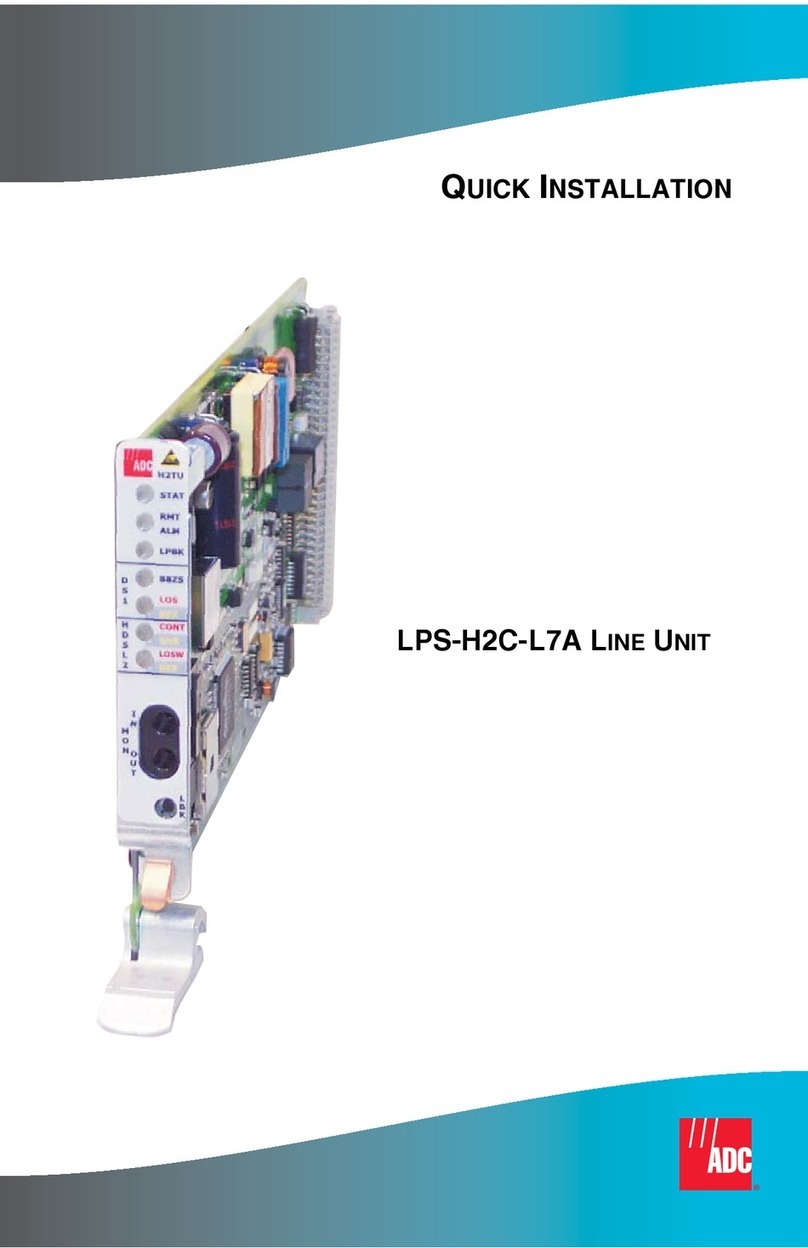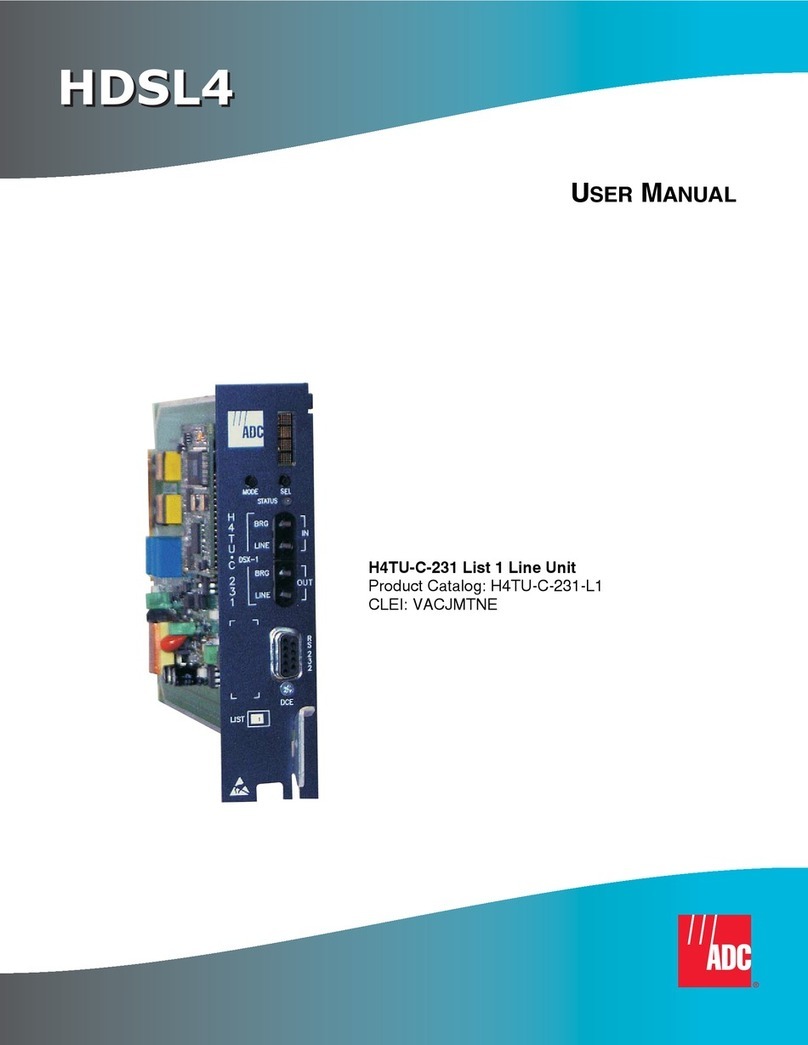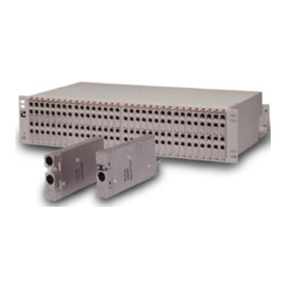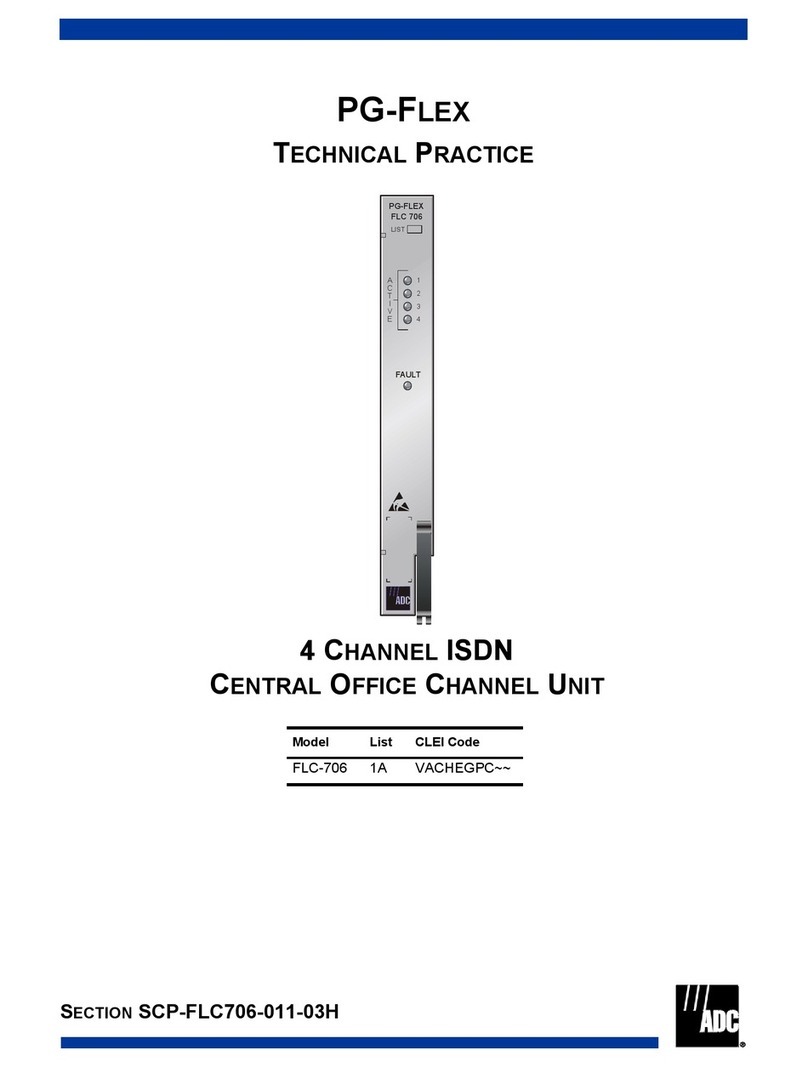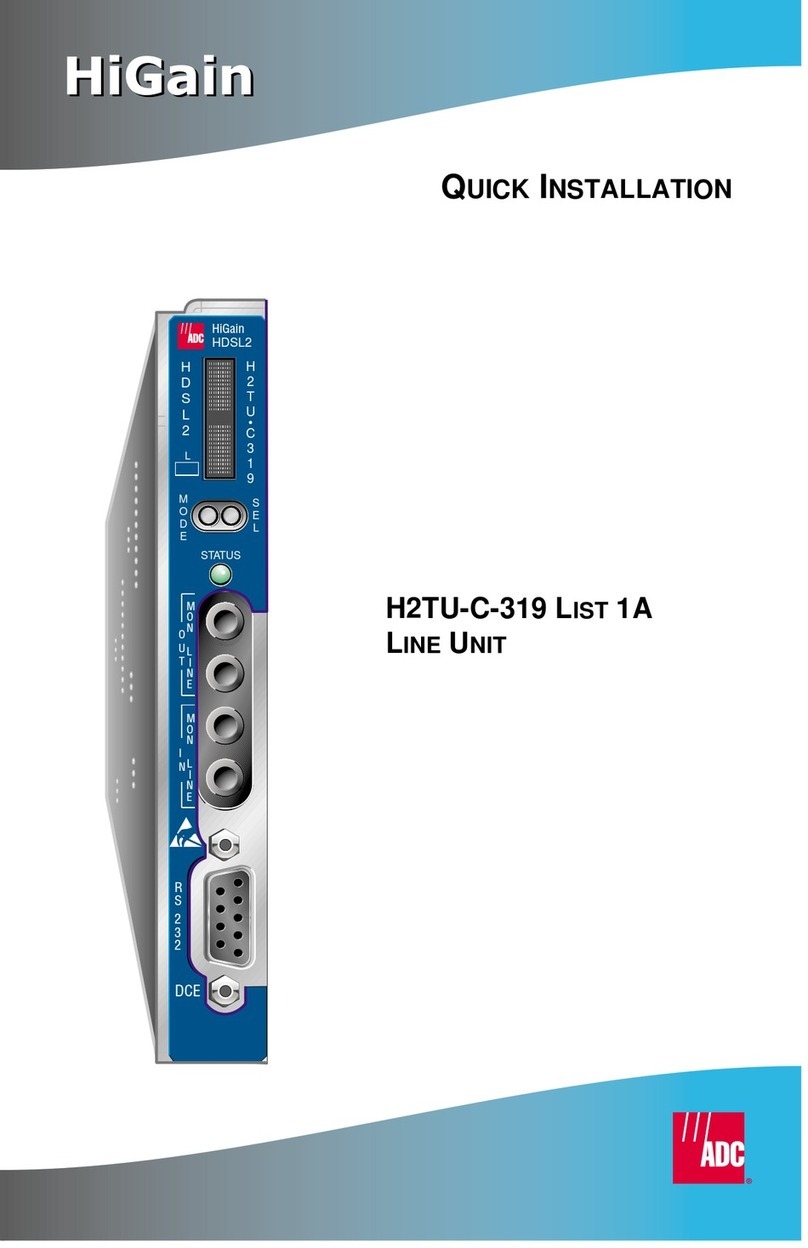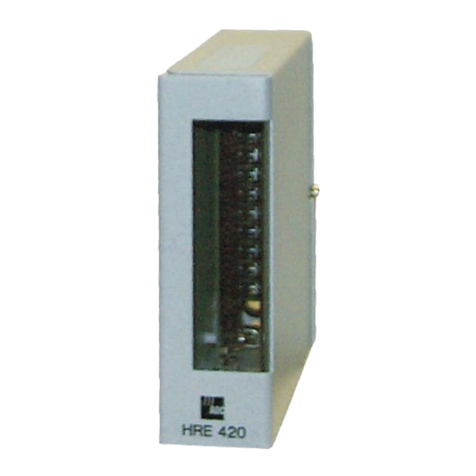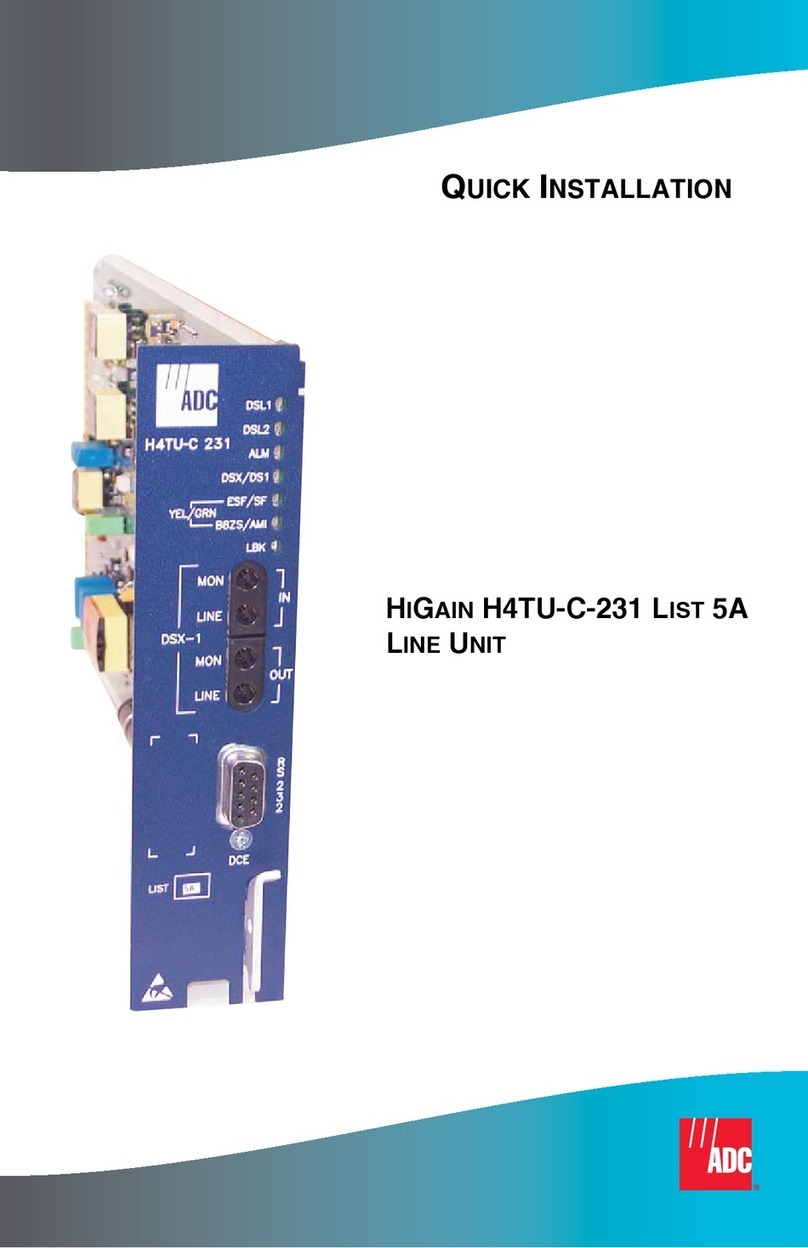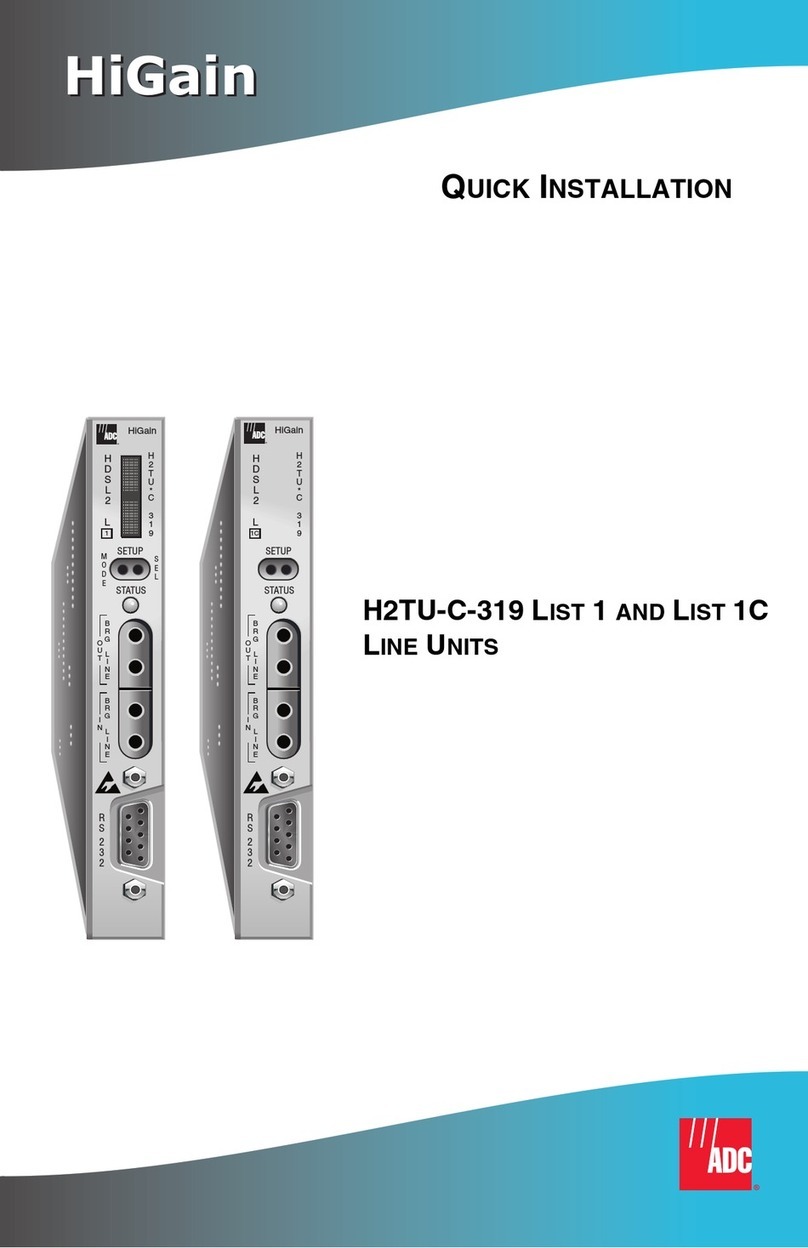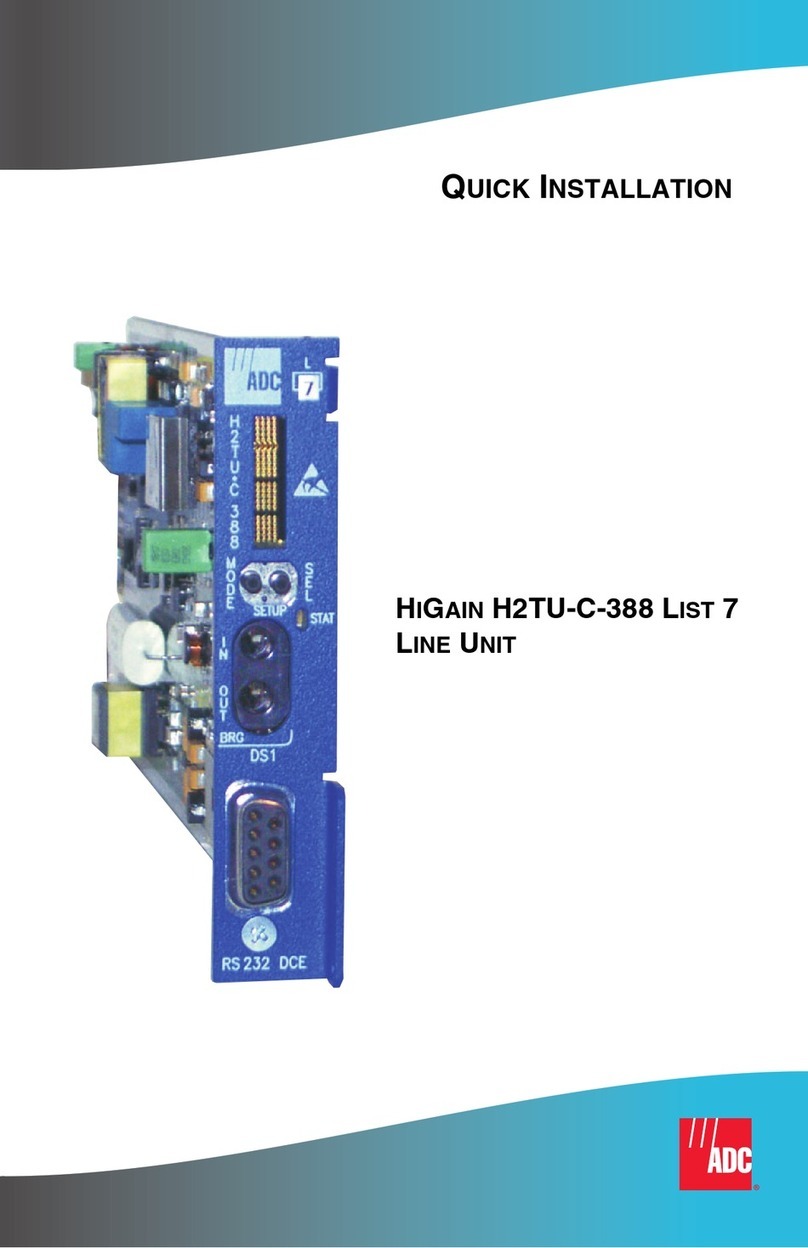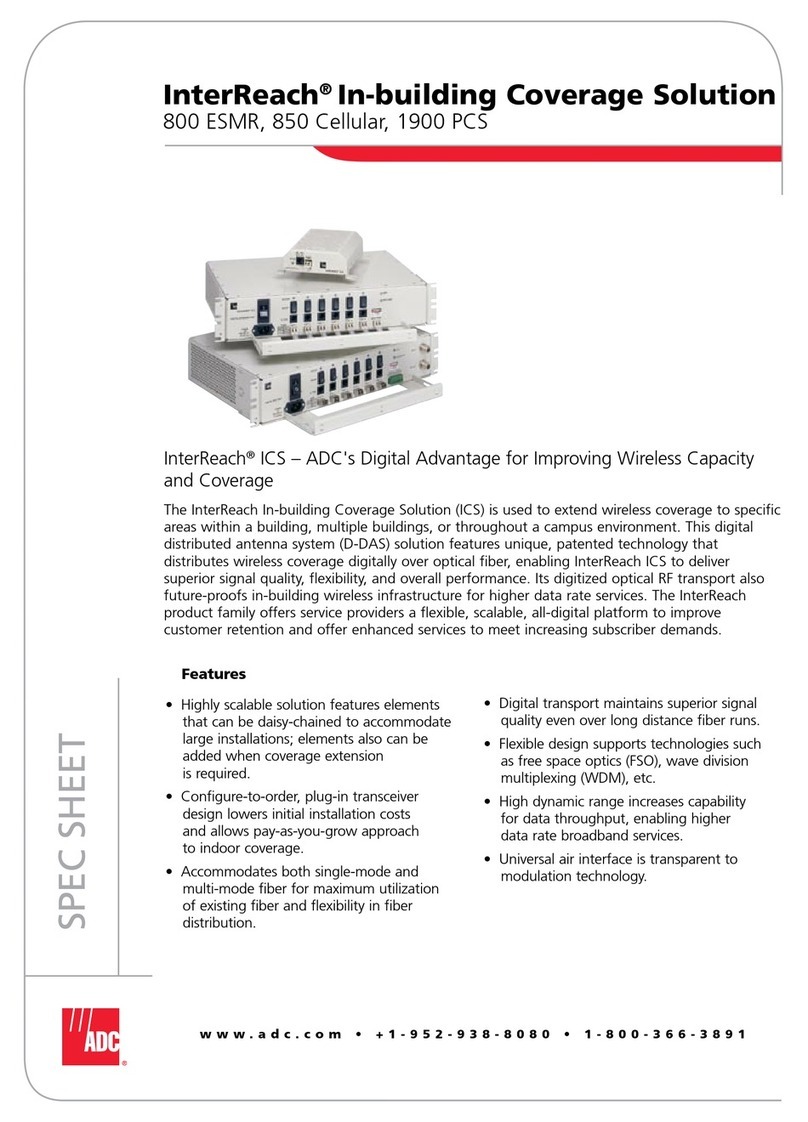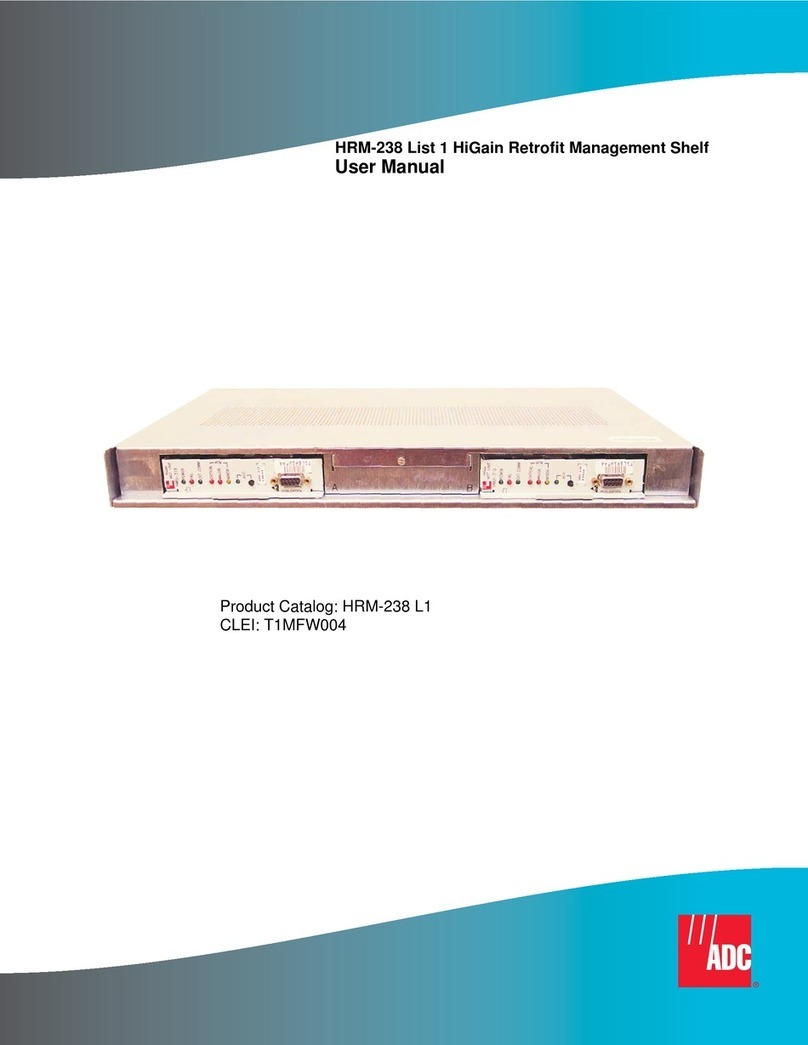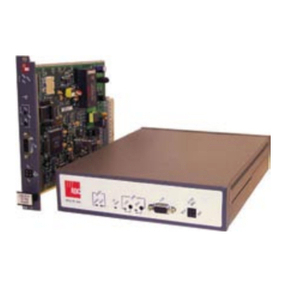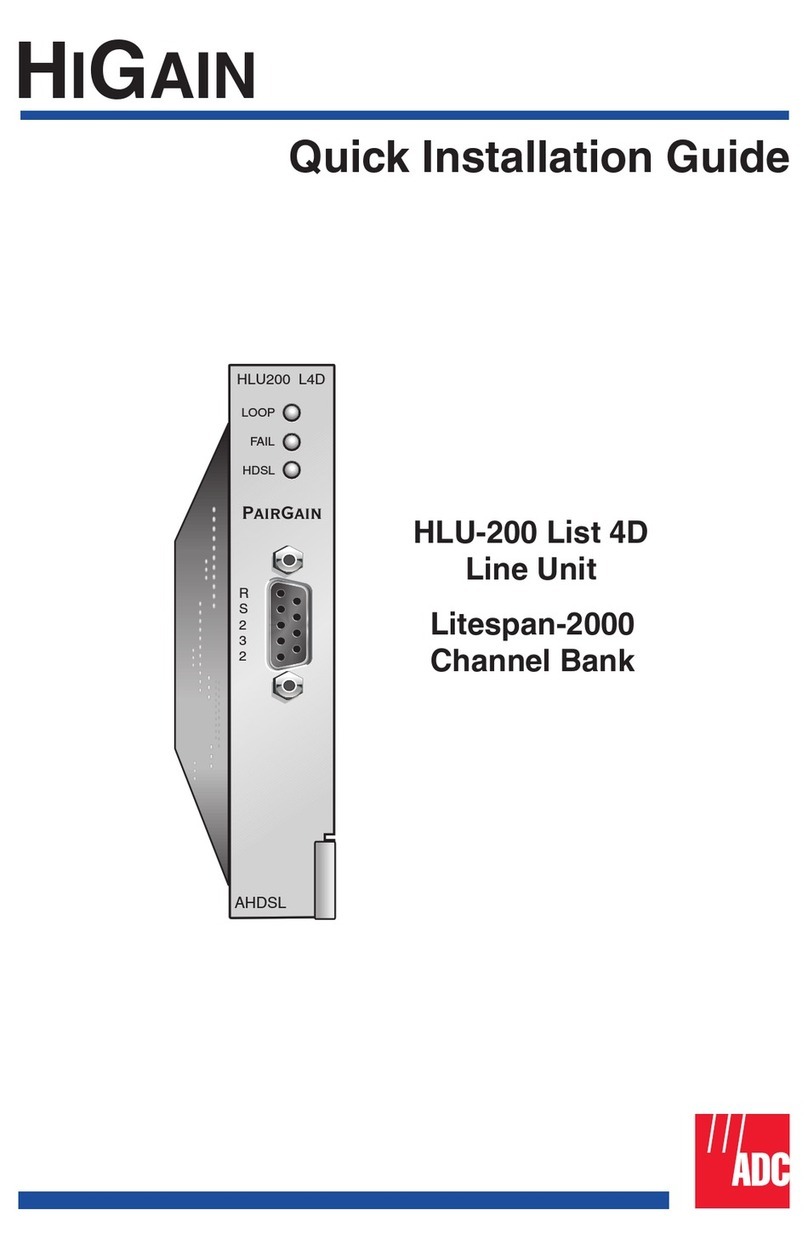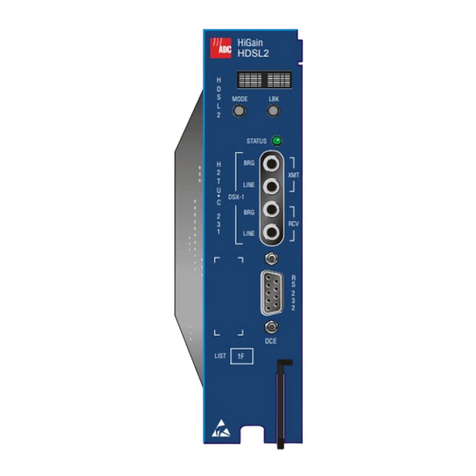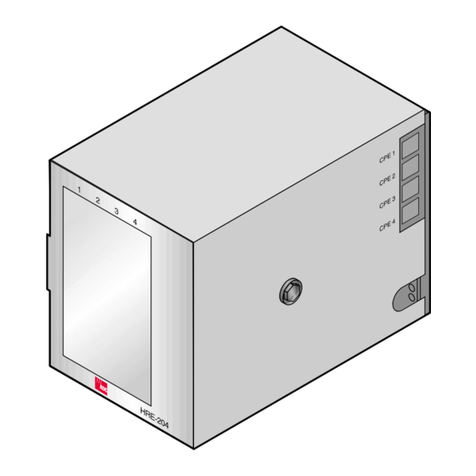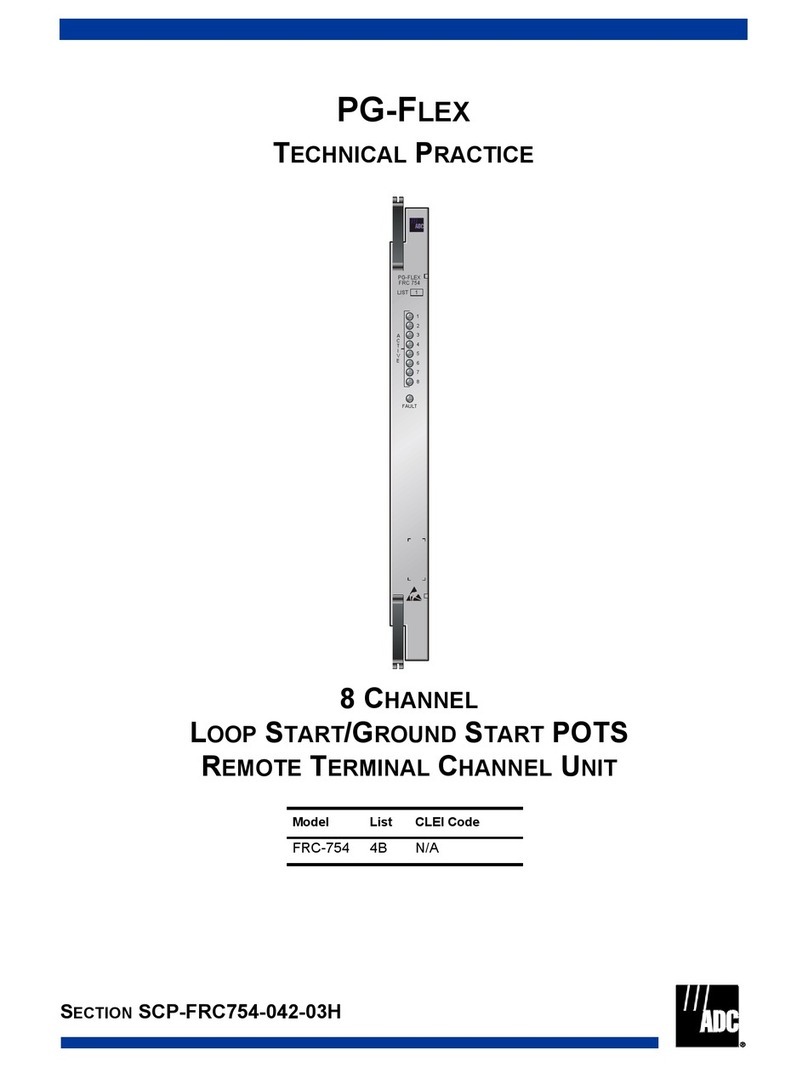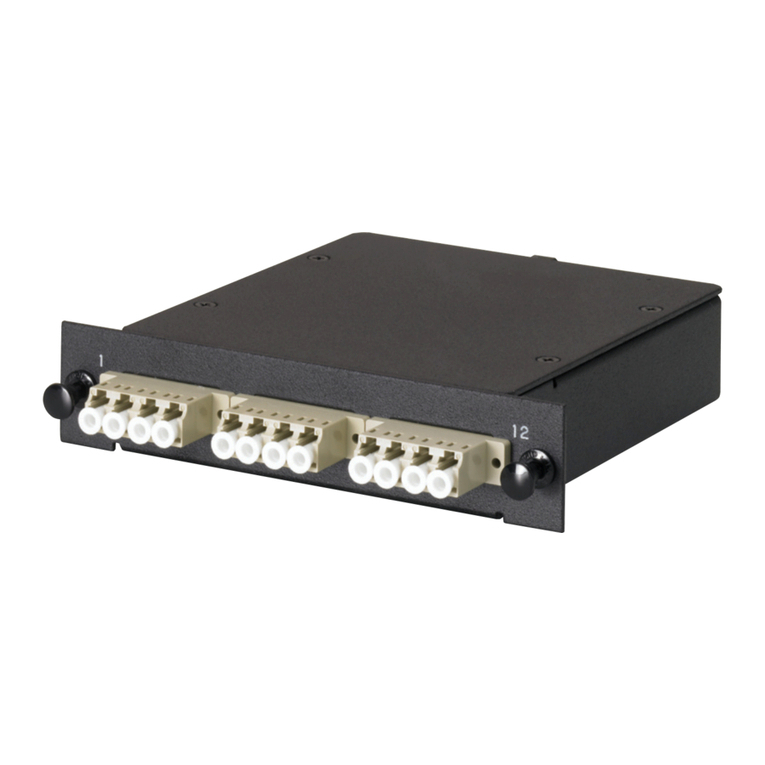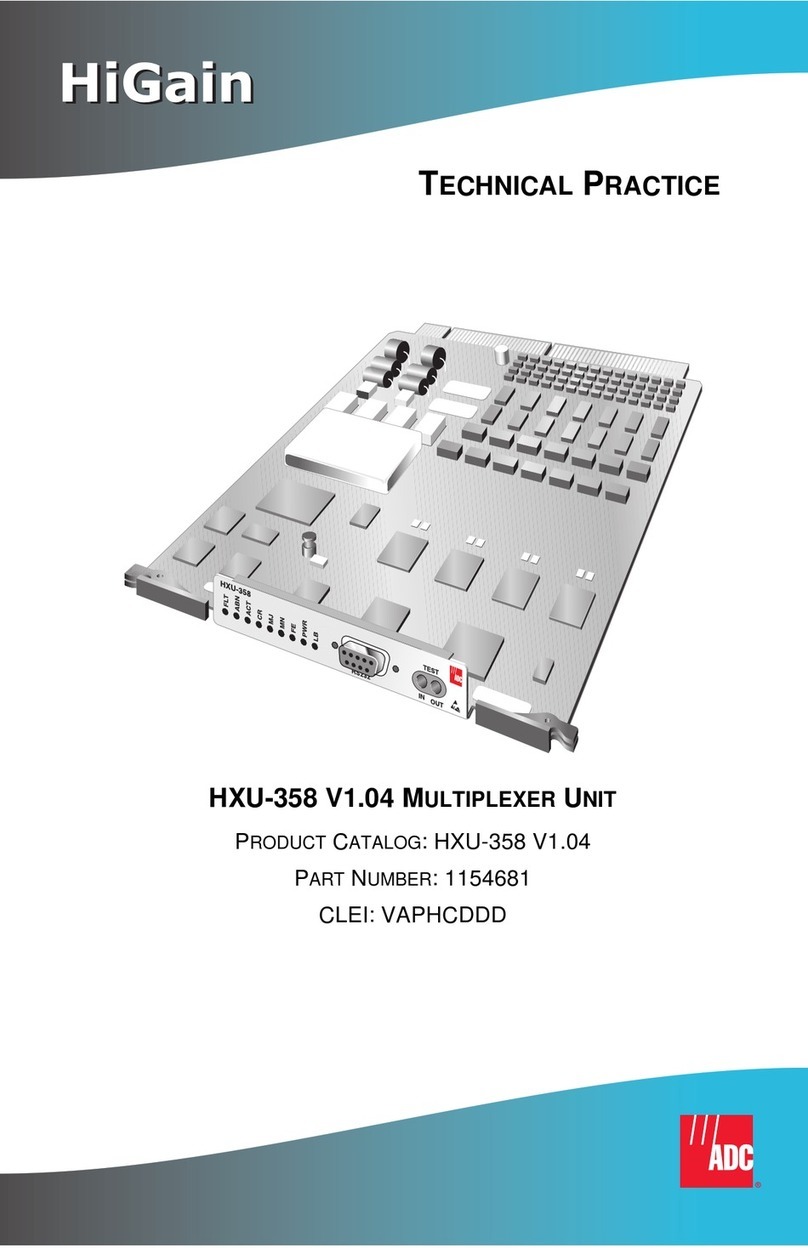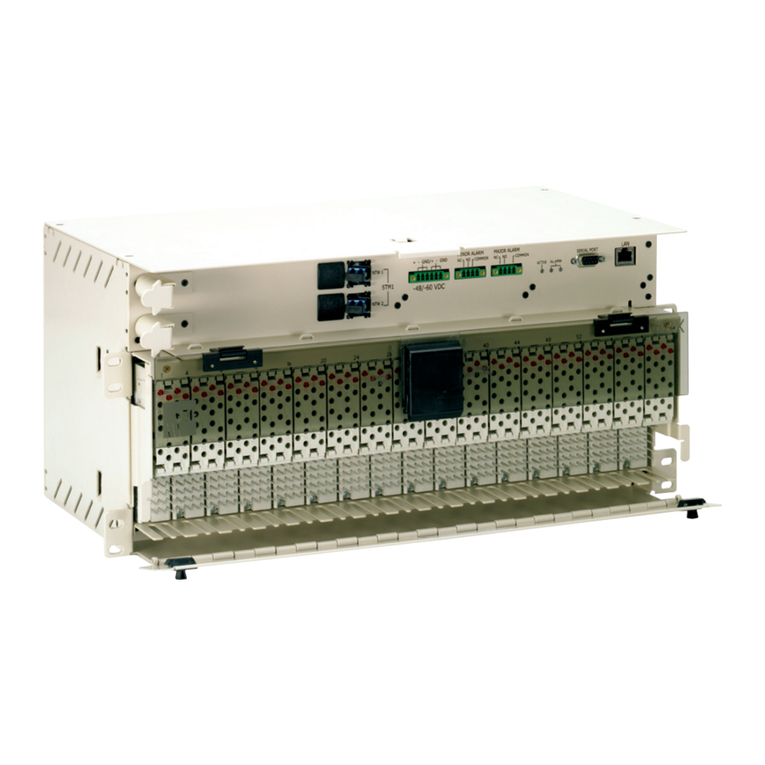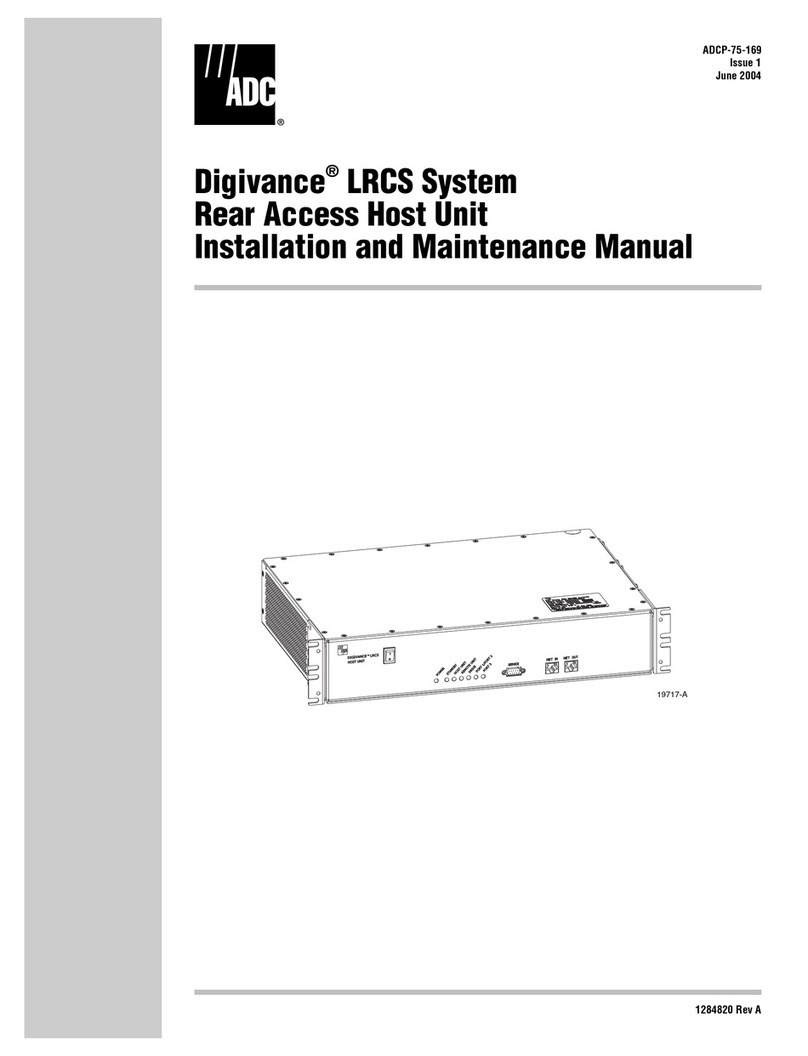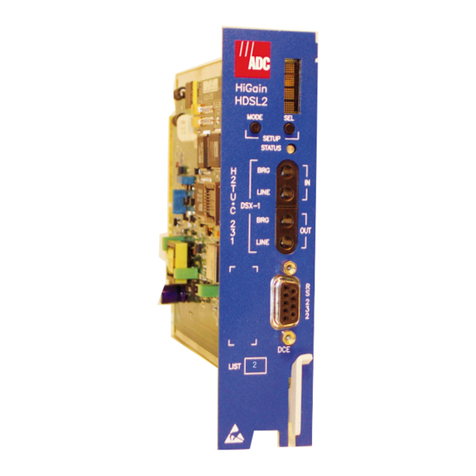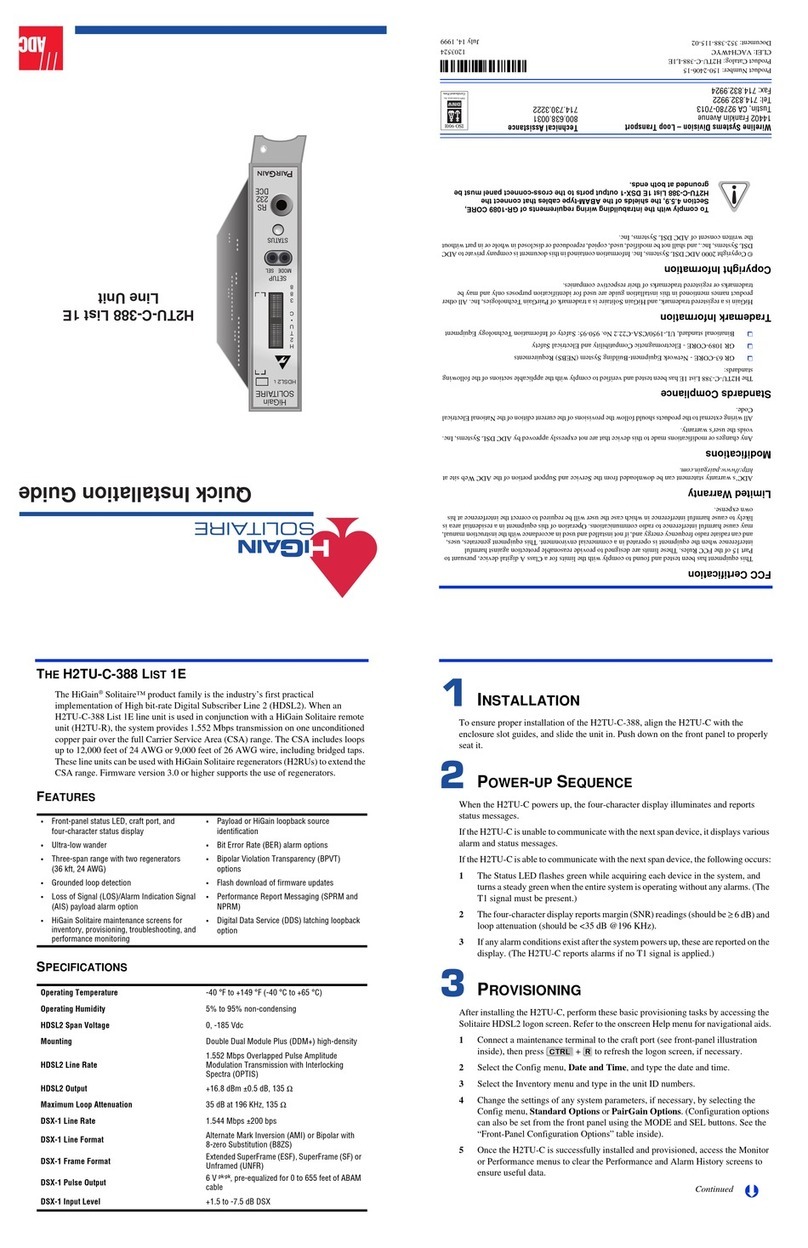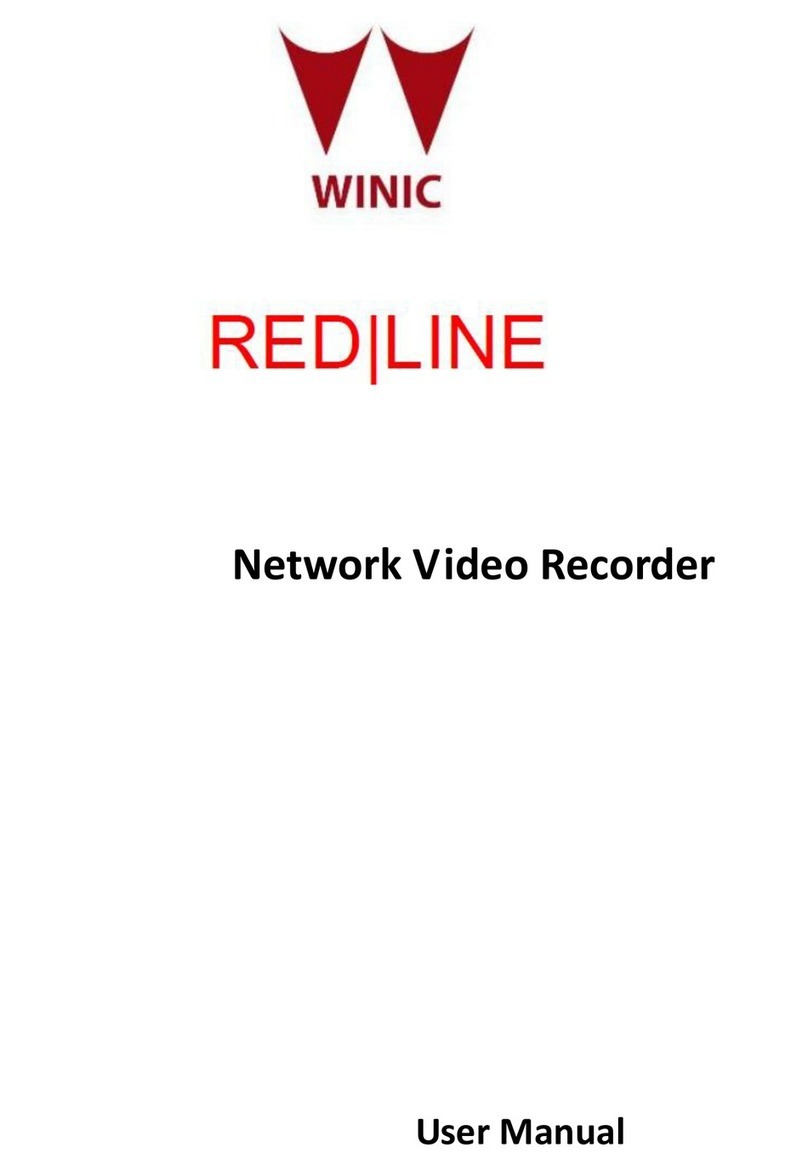
LOOPBACK TESTING
Initiate loopback testing from the HiGain maintenance menus or use the MODE and SEL
buttons. The inband codes shown in the table below can be sent by a test set.
106
105
104
103
102
101
100
DSX-1RCV
DSX-1XMT
HDSL2
HDSL1
205
204
203
202
201
200
119
118
117
116
115
114
113
112
111
110
Ground Ground
FrameGround
MJF*
Ring1
Ring1
Tip1
Tip1
(Mgmt.bus)
Ring
Ring
Tip
Tip
(Factoryburn-in)
-48Vdc
219
218
217
216
215
214
213
212
211
210
209
208
207
206
109
108
107
* MJF (major fuse alarm) is normally floating (0 to 80 V maximum)
and at -48 Vdc (10 mA maximum) when activated.
List number (HLU version number)
RS-232 Craft port
Bantam 210 jack provides bidirectional communication
between the unit and an external terminal by way of
DB-9 or DB-25 connector to allow configuration and
performance monitoring through the maintenance
terminal menus. (Use adapter for jack,
part number 120-1035-01.
CLEI code label
M
A
R
G
I
N
(dB)
L
RS
232
STATUS
SETUP
MODE SEL
Four-character display
Displays status, provisioning, and
alarm messages. See tables below
for a list of message descriptions.
Status LED
Reports the following conditions:
Self Test is in process, or a Customer
Remote Loopback (CREM) or Network
Local Loopback (NLOC) is in effect
Green LED Normal operation
Flashing Green LED HDSL acquisition
Red LED Fuse alarm
Flashing Red LED System alarm
Yellow LED
FlashingYellow LED
Configuration number
System is in Armed (ARM) mode
System option buttons (for manual setting of
system parameters)
Use MODE and SEL to manually modify user options,
initiate loopbacks, and display DSX-1 line parameters.
1
2
3
4
Press the MODE button for 3 seconds and release.
The front panel alternately displays the first
system parameter and its current setting.
Press SEL to step through all possible system
settings for the displayed parameter.
Press MODE to update the parameter and advance
to the next parameter.
After scrolling through all the parameters, press SEL
to confirm changes when prompted with a CONF YES
message, or press MODE to cancel all changes.
1200-9600 baud
8 data bits
No parity
1 stop bit
Hardware flow control: OFF
Terminal emulation: VT100
Modem Settings
Front Panel Card-edge Connector
5F
HLU 388
HG HDIAIN
106
105
104
103
102
101
100
DSX-1RCV
DSX-1XMT
HDSL2
HDSL1
205
204
203
202
201
200
119
118
117
116
115
114
113
112
111
110
Ground Ground
FrameGround
MJF*
Ring1
Ring1
Tip1
Tip1
(Mgmt.bus)
Ring
Ring
Tip
Tip
(Factoryburn-in)
-48Vdc
219
218
217
216
215
214
213
212
211
210
209
208
207
206
109
108
107
* MJF (major fuse alarm) is normally floating (0 to 80 V maximum)
and at -48 Vdc (10 mA maximum) when activated.
List number (HLU version number)
RS-232 Craft port
Bantam 210 jack provides bidirectional communication
between the unit and an external terminal by way of
DB-9 or DB-25 connector to allow configuration and
performance monitoring through the maintenance
terminal menus. (Use adapter for jack,
part number 120-1035-01.)
CLEI code label
M
A
R
G
I
N
(dB)
L
RS
232
STATUS
SETUP
MODE SEL
Four-character display
Displays status, provisioning, and
alarm messages. See tables below
for a list of message descriptions.
Status LED
Reports the following conditions:
Self Test is in process, or a Customer
Remote Loopback (CREM) or Network
Local Loopback (NLOC) is in effect
Green LED Normal operation
Flashing Green LED HDSL acquisition
Red LED Fuse alarm
Flashing Red LED System alarm
Yellow LED
FlashingYellow LED
Configuration number
System is in Armed (ARM) mode
System option buttons (for manual setting of
system parameters)
Use MODE and SEL to manually modify user options,
initiate loopbacks, and display DSX-1 line parameters.
1
2
3
4
Press the MODE button for 3 seconds and release.
The front panel alternately displays the first
system parameter and its current setting.
Press SEL to step through all possible system
settings for the displayed parameter.
Press MODE to update the parameter and advance
to the next parameter.
After scrolling through all the parameters, press SEL
to confirm changes when prompted with a CONF YES
message, or press MODE to cancel all changes.
1200-9600 baud
8 data bits
No parity
1 stop bit
Hardware flow control: OFF
Terminal emulation: VT100
Modem Settings
Front Panel Card-edge Connector
5F
HLU 388
HG HDIAIN
Table 1. GNLB Loopback Commands
Loopback Inband Code Description
NLOC 1111000 DSX-1 signal is looped back to the network at the HLU.
NDU1 110000 DSX-1 signal is looped back to the network at HDU 1.
NDU2 111000 DSX-1 signal is looped back to the network at HDU 2.
NDU3 1010001 DSX-1 signal is looped back to the network at HDU 3
NDU4 1010010 DSX-1 signal is looped back to the network at HDU 4
NREM 1110000 DSX-1 signal is looped back to the network at the HRU.
SMJK 11000 DSX-1 signal is looped back to the network at the HRU SmartJack module.
CREM 1111110 Signal from customer is looped back to the customer at the HLU.
CDU1 111100 Signal from customer is looped back to the customer at HDU 1.
CDU2 111110 Signal from customer is looped back to the customer at HDU 2.
CDU3 1011001 Signal from customer is looped back to the customer at HDU 3.
CDU4 1011010 Signal from customer is looped back to the customer at HDU 4.
CLOC 1111100 Signal from customer is looped back to the customer at the HRU.
Loopdown 11100 Loops down any of the above loopbacks.
For more detailed information about the Maintenance Terminal
screens, provisioning, and loopback mode testing, refer to the
HLU-388 List 5F technical practice, document number
150-388-156-xx. It can be downloaded from the Customer Site portion
of the ADC Web page at www.adc.com. A password is required to
access the Customer Site Web pages. If you do not have a password,
contact your ADC sales representative.
Table 2. Front-Panel Alarm Messages
Message Description
LOSW Indicates that one of the HDSL loops has lost sync.
LLOS Indicates that no signal is detected at the DSX-1 input to the HLU.
RLOS Indicates that no signal is detected at the DS1 input to the HRU.
BER A system Bit Error Rate alarm is in effect.
MAL1 or MAL2 The margin on HDSL Loop 1 or Loop 2 has dropped below the threshold set by the user.
NONE No alarm present.
NOTE: Alarm (ALRM) displays priorto an alarm message. Pressing the SELbutton initiates an Alarm Cutoff (ACO) condition.
Table 3. System Configuration Codes
Code Description
VER xxxx The release revision of the firmware (appears during the System Settings review mode).
LIST xxxx The model number of the product (appears during the System Settings review mode).
FRM xxxx Indicates the type of frame pattern being received from the DSX-1, where xxxx is SF,
ESF, UNFR, or NONE).
CODE xxxx The line code setting, where xxxx is Alternate Mark Inversion (AMI) or Bipolar with
8-Zero Substitution (B8ZS).
PLEV xxxx Indicates the HDSL line voltage in its LOW (-140 Vdc), HIGH (±112 Vdc), or DIS
(disabled state).
Table 4. Front-Panel Diagnostic Messages
(normal operating messages in bold)
Message Description
1=xx or 2=yy Indicates the powerof the received HDSL signal oneach looprelativeto noise. Anyvalue
of 6dB or greater is adequate for reliable system operation.
nHDU Indicates the number (n) of doublers in the circuit (if any are present).
INSL xxdB ThemaximumInsertionLossmessage(INSL)appearsfollowedbyxxdB,where xxisthe
maximum insertion in dB of all spans and loops.
ACQ1 or ACQ2 The multiplexers of the HLU and the HRU or the first doubler are trying to establish
synchronization over Loop 1 or Loop 2 of Span 1.
AnL1 or AnL2 ThemultiplexersofthetwodevicesonSpannaretryingtoestablishsynchronizationwith
each other on Loop 1 or Loop 2, where nis the number of the span.
BAD RT? The HLU is not receiving any response from the HRU.
FERR Framing bit error occurred at HLU DSX-1 input.
H1ES or H2ES HDSL Loop 1 or Loop 2 CRC error.
LBPV A local bipolar violation has been received at the DSX-1 input to the HLU-388 List 5F.
MNGD The HLU is under control of the HMU-319 Network Management Unit.
PWR FEEDGND One of the HDSL loops has been grounded.
PWR FEED ON Indicates that the HDSL loops are not grounded or shorted.
PWR FEED OFF HDSL span power has been turned off.
PWR FEED SHRT IndicatesashortbetweenthetwoHDSLpairsortheinabilityoftheHRUtocommunicate
with the HLU.
SELF TEST The HLU is in a self-test mode. This occurs every power on/off cycle.
SIG1 or SIG2 The transceivers of the HLU and HRU or first doubler are trying to establish contact with
each other on Loop 1 or Loop 2 of Span 1.
SnL1 or SnL2 The transceivers of the two devices on Span nare trying to establish contact with each
other on Loop 1 or Loop 2, where nis the number of the span.
TLOS HRU is in a logic loopback state caused by a loss of its T1 input from the CI (if enabled
at the HRU through its TLOS switch option).
Table 5. System Settings
Display Code Description (default values in bold)
EQL Sets the Equalizer (EQL) DSX-1 to: 0 (0 to 133 ft.), 133 (133 to 266 ft.), 266 (266 to 399
ft.), 399 (399 to 533 ft.), 533 (533 to 655 ft.).
LPBK Enables (ENA) or disables (DIS) all inband SMJK loopback commands.
SPLB Configures the system for generic inband loopback commands(GNLB) or special
loopback commands (A1LB, A2LB, A3LB, A4LB, A5LB).
PWRF DIS = disables HDSL powering.
LOW = HDSL line voltage at -140 Vdc maximum.
AUTO = automatically switches between -140 Vdc for non-doubler applications and
±112 Vdc for doubler applications.
HIGH = ±112 Vdc for all applications.
ZBTS ON = ESF frame is operating in its Zero-Byte Time Slot Interchange (ZBTSI) mode.
OFF = ESF frame is operating in its normal non-ZBTSI mode.
BERT NONE = prevents generation of a system alarm due to excessive BER.
1E-6 or1E-7 = alarm activateswhen BER threshold exceeds 10-6 or 10- 7, respectively.
LBTO Loopback timeout = NONE, 20, 60, 120 minutes.
DS1 Line code = places the HLU and HRU in B8ZS, AUTO or AMI mode.
FRMG AUTO = configures the HiGain system to operate in an auto-framing mode.
UNFR = configures the HiGain system to operate in an unframed mode.
HAIS 2LP = transmits the AIS signal at both the HLU and the HRU T1 output ports when both
HDSL loops are not in sync (LOSW); 1LP =applieswhen eitherof the twoHDSL loopsare
not in sync or if a Margin alarm occurs.
SAIS Enables (ENA) or disables (DIS) transmission of AIS signal during NREM/SMJK
loopbacks.
RDA Enables (ENA) or disables (DIS) alarm indications due to remote DS1 LOS at HRU input.
ALMP Enables a line to outputan (AIS) payload ofall onesor an (LOS)condition at its DS1 ports
for LOSW, DS1 LOS, and margin alarms.
BPVT Enables (ENA) or disables (DIS) bipolar violation transparency (conversion of input DS1
BPVs and HDSL CRC errors into DS1 BPVs at the distant end’s DS1 output port).
MARG(a)
(a) MARG can only be set through the Maintenance Terminal.
Sets Margin Alarm Threshold (0 to 15 dB). Default = 4dB.
DS0(b)
(b) DSO can only be set through the Maintenance Terminal.
NONE = no DS0 channels blocked; BLK = some channels blocked.
CONF YES = confirms that all operating modes are to be updated to their current selections.
NO = prevents the most recently selected operating mode selection from being updated.
